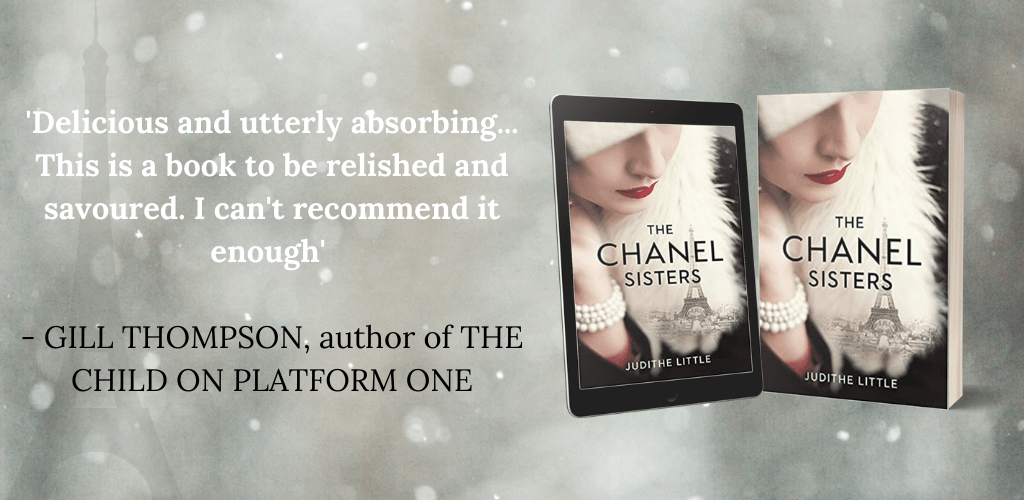The meaning behind the Chanel logo

The Chanel sisters and the meaning behind the Chanel logo
Judithe Little
What do you think of when you see the famous interlocking Cs of the Chanel logo? Luxury, of course. Status, wealth, expensive quilted bags, tweed suits, pearls, perfumes and all things Parisian.
You probably assume the logo is a play on Coco Chanel’s initials. I definitely did, until I started research for The Chanel Sisters. In the process of digging up what information I could about the relationship between Coco and her sister Antoinette, I learned that not all is as it appears to be with respect to the petite, dark-haired force otherwise known as ‘Mademoiselle’. Coco kept her background and her personal life very close to the bouclé vest. The woman had secrets. A lot of them. And, as you shall see, a playful sense of irony.
So let’s rewind the clock and delve 100 plus years into the past, back to when Coco wasn’t yet known as Coco, but Gabrielle. And who better to take us there than the mysterious Antoinette Chanel. Coco’s real-life younger sister was the one person who knew exactly what Coco had to hide. Not only that, Antoinette played a crucial supporting role in the founding of what we know today as the Chanel empire.
Yet not a lot is known about her. She lurks only in footnotes by Coco’s biographers. Until now. In The Chanel Sisters, Antoinette reclaims her voice. And, as any little sister might, she tells all. Although in actuality, she took Coco’s secrets to the grave.
The greatest of these secrets, the one Coco spent her entire life trying to cover up, was the fact that she was born in the poorhouse. Yes, the human embodiment of all things Parisian chic came into this world as the daughter of paupers. An illegitimate, out-of-wedlock daughter of paupers. The Chanel sisters’ ne’er-do-well father, Albert, was a travelling peddler of women’s underthings and, correspondingly, a serial philanderer. He came home just long enough to impregnate their lovestruck mother, Jeanne. And in the end, there were five surviving Chanel siblings. Poor Jeanne took on backbreaking work as a laundress to put scraps of food on the table in his absence and when the children were still young, she died of consumption. Albert promptly abandoned Coco, Antoinette, and their older sister, Julia-Berthe, at the doorstep of a convent orphanage deep in the provincial heart of France.
Prospects for ‘charity cases’ like the Chanel sisters were grim. The nuns told them they would be lucky to find a low-level tradesman or clerk to marry them. They were taught skills like sewing so they could fend for themselves, if need be, in menial jobs that meant long hours, low wages and intense physical strain. This was the best they could hope for.
Yet Coco and Antoinette weren’t having it. Picture, if you will, the two sisters during Mass in the convent chapel, their fingers laced in prayer, their small frames dressed in wooly black uniforms. Their gaze is drawn to the light coming in from the tall, arched windows and they trace with their eyes the patterns in the stained glass, hour after hour, imagining a better future for themselves. What that will be, they don’t know. All they are sure of is there must be something better.
Is it a coincidence that the patterns in those windows – the very prisms of their dreams – –were overlapping circles made up of interlocking Cs? I don’t think so. Coco didn’t talk about where she came from, but she kept reminders of it all around her. She understood that we are all a tapestry of our past, of the threads that make us, woven together like a nubby wool. And she was superstitious. She surrounded herself with lucky charms: lions for her Leo astrological sign, sheaves of wheat for prosperity, tarot cards and rock crystal. She considered the number five her lucky number. It must have worked: Chanel No. 5 made her rich.
Coco would not have been one to take a logo lightly.
In addition to the chapel windows, other theories have been tossed around as to the logo’s origins. Some say she copied it from a 16th century French queen, Catherine De’ Medici. Others say it refers to her affair with the wealthy Englishman Arthur ‘Boy’ Capel.
It could have been a mix of all of these. But what about Antoinette?
It was Antoinette at Coco’s side when she started out selling hats in 1910. And Antoinette who, during World War I, helped Coco set up shop in the resort town of Deauville that showcased the famous fisherman shirts, comfortable sweaters, and sportswear – a new concept for the time. Later in the war, Antoinette was dispatched to Biarritz. There, she opened a third boutique to offer Chanel evening gowns and couture principally to Spanish aristocrats and royalty. Antoinette oversaw a staff of more than 100 employees. She managed a demanding clientele and a demanding older sister. By the end of the war, the Chanel brand was famous.
So here is the irony, the clever trick Coco has played on us all. The Chanel logo stands for luxury, but it also stands for two young girls who came from nothing, gazing out the window of a convent orphanage dreaming of a better life. I like to think of those interlocking Cs as Coco and Antoinette, two Chanels arm-in-arm, sisters who against all odds managed to rise above poverty and create a legacy that endures today.
The Chanel Sisters is available now in paperback, ebook and audio. Pick up your copy here






